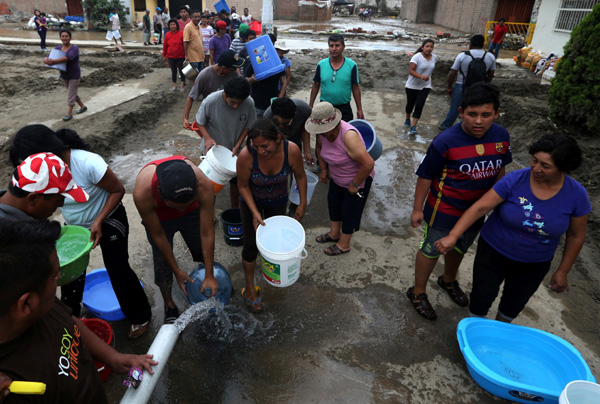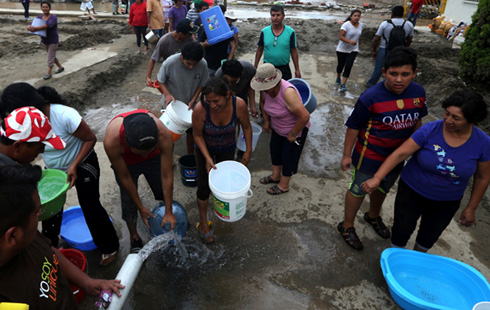Peru hit by drinking water shortage as death toll in flooding up over 70
 |
|
Flood survivors receive water after rivers breached their banks due to torrential rains, causing flooding and widespread destruction in Huachipa, Lima, Peru, March 18, 2017. [Photo/Agencies] |
LIMA - Carrying bottles, buckets and other containers, thousands of residents of Lima are in the streets in search for drinking water, as restrictions or cuts have affected Peru's capital for the fifth straight day.
A visible evidence of the magnitude of the crisis is that the pool of Peru Square, right next to the presidential palace, was emptied by hundreds of people. Other public fountains have similarly been turned empty, despite the hundreds of tanker trucks delivering water across the city.
The shortage of water is due to to landslides of mud and stone that have fallen into the Rimac river and other tributaries on which the capital relies. The solid residue has overwhelmed the city's La Atarjea treatment plant's ability to process it into drinking water.
"We cannot deliver turbid water, water with earth. Doing so...would cause permanent damage," said Rudecindo Vega, President of Lima's water utility, SEDAPAL, to explain the situation to the press.
However, supplies of bottled water have practically disappeared from stores due to high demands, while certain people have taken advantage of the situation and selling water at a highly inflated price.
The situation has become critical in Lima's more populous areas and suburbs where water, unsafe to drink and normally stored in cisterns to be used in parks, has been taken.
Prime Minister Fernando Zavala has called on residents to take extreme care of the limited water and to ration its use, while expressing hope the strong rains will stop and SEDAPAL can begin processing water again.
While it seems contradictory, Peru has a great many sources of drinking water. However, access to it does not reach its 30 million residents. Eight million Peruvians do not have drinking water and are obliged to rely on tanker trucks, usually not receiving enough for basic sanitary requirements.
The latest report by the Operations Center for National Emergencies on Saturday night showed that the death toll nationwide has climbed to over 70, with 170 injured and nine missing.
72,115 people have lost their homes, 567,551 people have been affected and 119,084 buildings have been damaged.
These numbers are likely to rise as more remote areas of Peru rapport in and with rain set to continue into April.

























